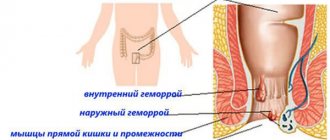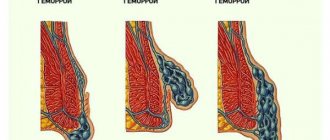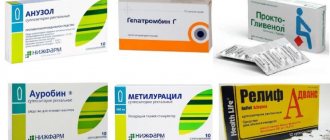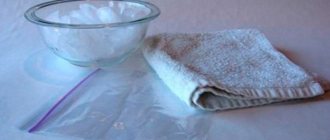Get advice Hemorrhoids require timely diagnosis and elimination. Due to myths that surgery is the only treatment and that surgery to remove hemorrhoids is painful, many patients ignore this serious disease. Therefore, it is important to know how hemorrhoids are treated, what surgical and therapeutic methods are used.
Pathology involves the formation of hemorrhoids from the veins around the rectum. The external form is easy to detect on your own; it consists of convex bluish formations around the anus. Accompanied by severe pain and mild bleeding.
The internal form is the formation of hemorrhoids in the rectum. In the initial stages it proceeds hidden. Causes itching and pain during defecation; traces of blood can be found on toilet paper and underwear.
How are hemorrhoids treated?
To diagnose the disease, an external examination and digital examination are often sufficient. Rectoscopy and rectal ultrasound are also used. How hemorrhoids are treated depends on the form and stage of the disease.
Surgery is aimed at removing the nodes. This includes:
- Longo operation;
- transanal hemorrhoidal dearterilization;
- hemorrhoidectomy.
Treatment for hemorrhoids without surgery includes:
- fight against constipation;
- phytotherapy;
- massage;
- antihemorrhoidal drugs;
procedures aimed at bleeding and spontaneous death of nodes.
Causes
The immediate cause of the appearance of external hemorrhoids is overstrain of the walls of the hemorrhoidal veins, caused by high physical activity (most often weight lifting) and, accordingly, excess blood flow. Sometimes external hemorrhoids are provoked by pushing during constipation or severe diarrhea.
As a rule, protrusion of the node occurs with significant thinning of the blood vessels, which can be caused by the following factors:
Is it possible to cure hemorrhoids without surgery?
In order to avoid unjustified fears about therapy, you should find out how hemorrhoids are treated and how effective each method is. The methods listed below are relevant for both external and internal forms of pathology.
Laser treatment
The technique involves laser destruction of a hemorrhoidal node measuring from a few millimeters to 2-3 cm. The duration of the procedure is 10-45 minutes, in complex cases – up to 1.5 hours. It is painless, most often under local anesthesia. It is most often used as a treatment for external hemorrhoids.
Ultrasound sclerotherapy "Proxon"
The procedure involves injecting a medicinal substance (sclerosant) into the dilated veins. Exposure to low-frequency ultrasound using the Proxon device allows you to distribute the drug evenly. The sclerosant causes adhesion, subsequent bleeding of the veins and death of the hemorrhoid, which falls off during defecation.
The manipulation lasts 5-7 minutes and is almost completely painless. There is no need to use anesthesia. This method is effective at stages 2-3 of the disease.
Latex ligation
A low-traumatic way to remove hemorrhoids. It consists of fixing the nodes with latex rings at the base. This leads to the cessation of blood supply to the vascular bundle. The hemorrhoid dies on its own.
The procedure lasts a maximum of an hour, is absolutely painless and does not require anesthesia. Often used to eliminate stage 2 internal hemorrhoids.
Radio wave surgery "Surgitron"
Radio wave treatment with the Surgitron apparatus is an atraumatic method of treatment performed using high-frequency waves. The incision and coagulation of tissues is carried out non-contactly with an electrode that evaporates the cells. First, the cytoplasm is destroyed, and then the organelles. The duration of the manipulation depends on the degree of the disease and the size of the external hemorrhoids. The treatment is painless and is carried out under local anesthesia.
Sclerotherapy
The procedure involves the introduction of a drug that glues blood vessels. Veins are overgrown with connective tissue. The nutrition of hemorrhoids stops, they decrease in size and die over time.
It is often performed to treat the internal form of the disease. The drug is administered using a syringe and controlled by an anoscope. Up to 2 hemorrhoidal cones are treated in one session. The procedure can be repeated after 10-14 days.
Infrared photocoagulation
Method of treatment of 1-2 degree pathology. It is carried out using a powerful beam of infrared rays. In the process, a scar is formed that prevents the flow of blood into the hemorrhoid. This leads to its depletion and death. Only one formation is affected per session. The procedure can be repeated after 2 weeks.
Ozone therapy
Many people are skeptical about this method and are not sure whether hemorrhoids can be treated in this way. The following are used as rectal ozone therapy:
- insufflation: stimulates metabolic processes, tissue regeneration;
- ozonated oil applications: has anti-inflammatory, disinfectant, wound healing and immunomodulatory effects.
Magneto laser therapy
A combination of low-intensity radiation and a magnetic field that enhances the effect of the laser. The procedure helps reduce the inflammatory process, reduce tissue swelling, and promote rapid healing and restoration. Conducted in a course of 7-10 sessions. Well tolerated and painless.
Drug treatment
The maximum effectiveness of therapy for hemorrhoids and medications is observed if drugs for external use and oral administration are used in combination.
The following names of medications are prescribed for oral administration:
- Detralex. The active components of the drug are hesperidin and diosmin, which effectively strengthen the walls of blood vessels and enhance the tone of cavernous veins. When using the drug Detralex at an early stage of the development of hemorrhoids, it is possible not only to completely get rid of the characteristic symptoms of the disease, but also to completely cure it.
- Aescusan. The pharmacological effect of this product is due to the inclusion of thiamine (vitamin B1) and natural horse chestnut extract in its composition. The drug is a herbal venotonic that has angioprotective, anti-inflammatory, antioxidant and decongestant effects.
- Troxevasin. This drug belongs to the category of classical venotonic agents with angioprotective properties. The active component of Troxevasin is the substance Troxerutin, which reduces the permeability of the walls of blood vessels, thereby eliminating signs of the inflammatory process.
- Phlebodia-600. The therapeutic effect of the drug Phlebodia-600 is due to the content of diosmin, which has angioprotective, anti-edematous and anti-inflammatory properties. The ability of the drug Phlebodia-600 to improve microcirculation in the blood vessels of the anorectal area has been clinically proven.
Prevention of hemorrhoids
Prevention of the disease is aimed at eliminating the factors contributing to its development. If you follow these rules, you will not need to worry about whether hemorrhoids can be cured. Such measures include:
- Diet. Exclusion of hot, spicy, fatty foods, fast food.
- Hygiene skills. Thorough toilet of the anus area.
- Physical activity. Elimination of a sedentary lifestyle. Performing exercises that normalize blood circulation in the pelvic area and intestinal motility.
If preventive measures are taken, the occurrence of pathology can be prevented.
However, if hemorrhoids have already formed, they can be easily cured, without pain or surgery, by resorting to one of the above procedures. To get a consultation
Symptoms
In the acute stage, external hemorrhoids are manifested by severe pain and/or burning in the anal area, severe inflammation and/or soreness of the hemorrhoids, as well as a feeling of discomfort when taking a sitting position. Sometimes bleeding of varying degrees of intensity may occur, up to the need for urgent hospitalization.
In the chronic stage, symptoms are less pronounced:
- patients notice traces of blood on toilet paper or underwear;
- with prolonged sitting or intense physical activity, discomfort occurs in the rectal area;
- mild, but long-lasting, pain of a pulling and/or aching nature is noted.
There are often cases when chronic hemorrhoids are asymptomatic for a long period and do not bother the patient at all.
Without sex - nowhere
Many people are sure that hemorrhoids are varicose veins, just not on the legs, but in a different place.
And these diseases are like brother and sister. It's not like that, they're more like cousins. The mechanisms of their development and risk factors are similar, but with hemorrhoids it is not the veins that are affected, but the mysterious cavernous bodies - these are tangles of blood vessels that connect the arteries to the veins. Anyone who understands a little about anatomy knows that thanks to exactly the same bodies, we can have sex. Male erection is the overflow of the corpora cavernosa with blood. Women also have such formations; there are fewer of them, but they are also very important during sex, especially for achieving orgasm. Why are they in the rectum? Not just for hemorrhoids. By filling with blood and changing volume, they help avoid such an unpleasant problem as incontinence. Not only were all these corpora cavernosa formed during development from one source, but they are also regulated by one nerve. It's called shameful. In the lower body area everything is so confusing. Article on the topic Hemorrhoids, polyps and cancer. The most “popular” diseases in proctology There is an opinion that hemorrhoids are best treated with folk remedies: doctors will heal you and during surgery you can die from bleeding. That's why many people look for recipes on the Internet. There you can find ways to cure hemorrhoids using aloe leaves, cucumber, potato candles, cherries with pits.
“The distributors of such recipes do not understand one thing - once they arise, hemorrhoids will not disappear,” explains the surgeon, Ph.D. medical sciences, researcher at the State Research Center of Coloproctology named after. Ryzhikh Ministry of Health of the Russian Federation Andrey Mudrov . “And if people feel better after an acute attack, this does not mean that they are free of the disease. The nodes remain, and this means there may be new exacerbations. Today there are several approaches to treating hemorrhoids, and patients have the right to choose the one that suits them best. Many people choose conservative treatment - with medications and without surgery. There is nothing wrong with this, hemorrhoids do not turn into cancer and rarely pose a threat to life, you can live with it like with any chronic disease. People try to follow the regime, take medications so that there are no new exacerbations. If they occur, they are treated with medications that help relieve symptoms. Many drugs are sold in pharmacies without a prescription. But this does not always eliminate the progression of the disease and the suffering associated with hemorrhoids. Therefore, surgery may become necessary over time.
We are now focusing on minimally invasive treatment methods: gentle, easier to tolerate, many are done on an outpatient basis or in a one-day hospital, without anesthesia. After them, recovery is quick and not as painful as after a classic operation to remove hemorrhoids. Previously, only this was done, and perhaps because of this, patients were afraid of such an operation. Minimally invasive surgery can completely cure hemorrhoids, but recurrences are possible. Such techniques include sclerotherapy, node ligation, and some others. A good effect is achieved by ligation of hemorrhoidal arteries with fixation of the nodes themselves (see infographic). As a result, they are switched off from the bloodstream and cannot fall out.”










